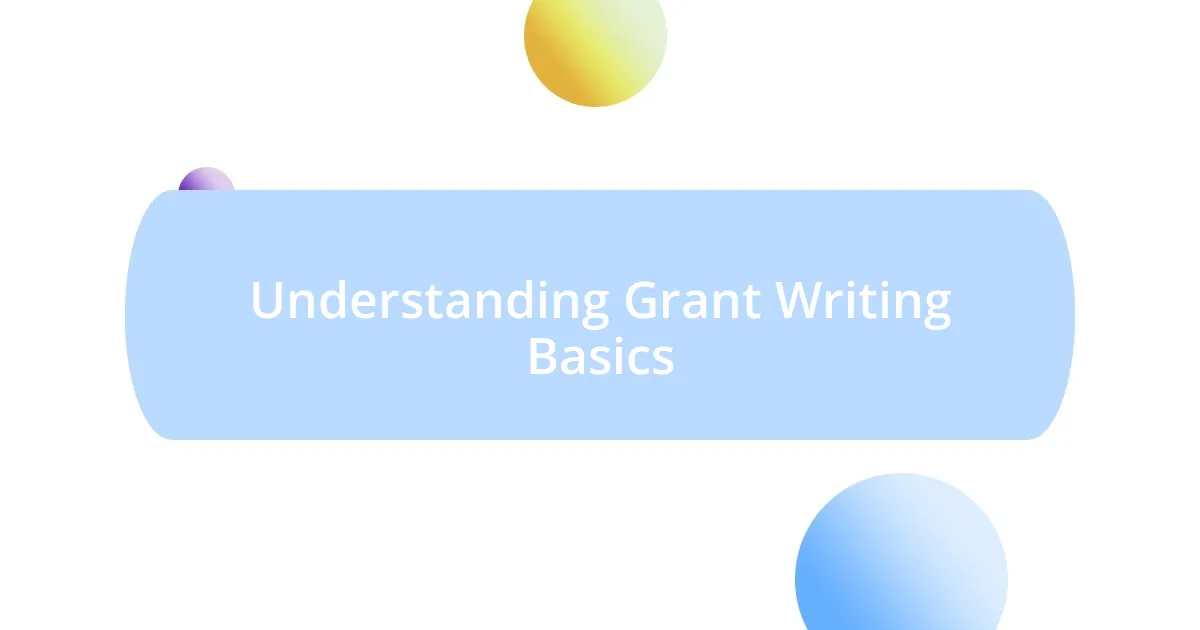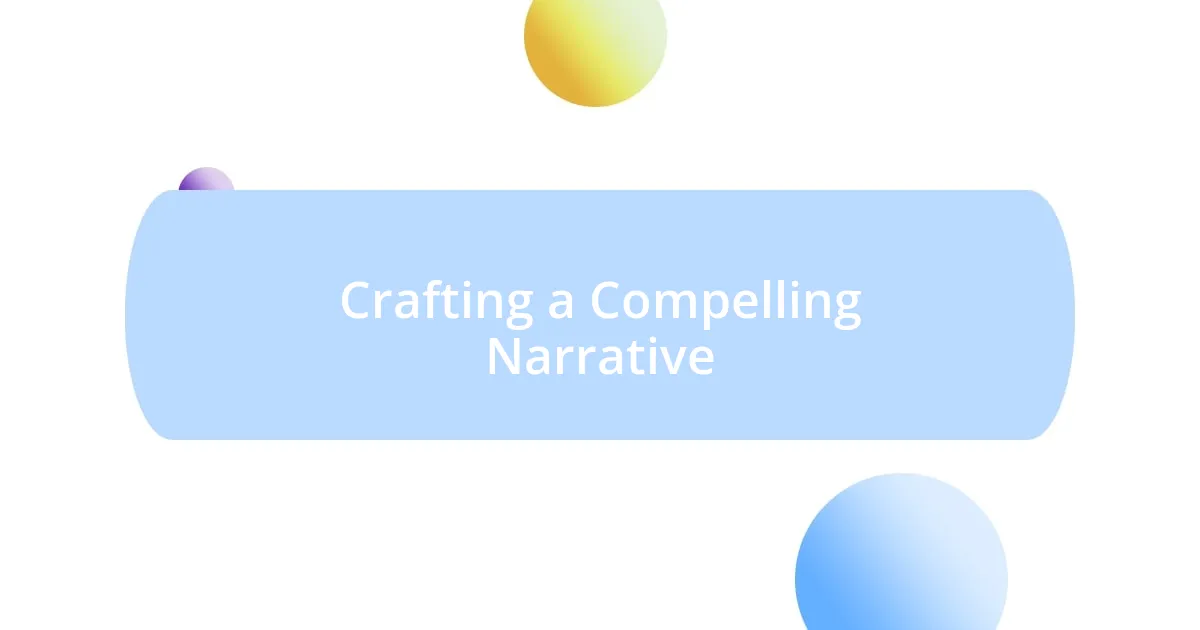Key takeaways:
- Grant writing combines clear communication and storytelling; personal anecdotes can strengthen emotional connections with funders.
- Identifying appropriate funding opportunities requires thorough research, networking, and maintaining an organized funding calendar.
- A compelling narrative in proposals includes personal connections, conflict resolution, and a strong call to action.
- Engaging stakeholders through collaboration and transparent communication encourages diverse input and enhances project proposals.

Understanding Grant Writing Basics
Grant writing is a blend of art and science, where understanding the fundamentals is crucial. I still remember my first grant proposal—it felt like deciphering a complex puzzle. The key is to breakdown the sections into manageable pieces, allowing your narrative to unfold logically and compellingly.
At its core, grant writing asks for clear and concise communication. Have you ever stared at a blank page, wondering how to convey your passion for a project? I’ve been there too. What I’ve learned is that clarity can be your ally; using straightforward language helps potential funders grasp the importance of your work right away.
One of my favorite techniques involves crafting a story that showcases the impact of your project. For instance, when I wrote a proposal for a community arts program, I included a vivid anecdote about how a young artist transformed their life through creativity. That personal touch resonated deeply with the reviewers. Think about your own experiences—how can you weave them into your proposal to create an emotional connection?

Identifying Funding Opportunities
Identifying the right funding opportunities is crucial to successful grant writing. In my experience, not all grants are a perfect match for every project. I make it a point to thoroughly research potential funders, their priorities, and their past funding activities. For example, I once spent hours diving into the records of a foundation that had previously supported arts education initiatives—and discovered they were looking to expand their reach to underrepresented communities. This insight shaped my proposal and ultimately led to securing that grant.
I also find that networking plays a vital role in identifying funding opportunities. Attending conferences and connecting with fellow grant writers can open doors to resources and insights that you might not uncover otherwise. When I first started writing grants, a colleague shared tips on specific grant databases and tools that have become invaluable to me. It’s amazing how a simple conversation can lead to discovering hidden funding gems.
Finally, I encourage keeping a funding calendar that outlines deadlines and priorities, enabling you to stay organized. Whenever I come across a potential funding source, I promptly jot it down, along with notes about their specific interests. This practice has helped me remain proactive rather than reactive in my grant-seeking efforts. What strategies do you employ to ensure you’re on top of funding opportunities?
| Method | Description |
|---|---|
| Research | Dive into funders’ previous projects to align your proposal. |
| Networking | Connect with peers to share insights and discover new opportunities. |
| Funding Calendar | Keep track of deadlines and priorities for different grants. |

Crafting a Compelling Narrative
Crafting a compelling narrative is about more than just presenting data; it’s about telling a story that captures the heart and mind of your audience. I’ve found that starting with a clear vision of what my project aims to achieve helps me weave an engaging narrative. For instance, when I wrote about a local environmental initiative, I framed the narrative around a relatable character—a local resident who witnessed firsthand the impact of pollution. This not only made the proposal more engaging but also helped funders visualize the project’s significance.
To ensure your narrative resonates with readers, consider these key elements:
- Personal Connection: Share your passion and how the project impacts your community.
- Characterization: Introduce real people who will benefit from the project, bringing their stories to life.
- Conflict and Resolution: Present a challenge your project will address, followed by how your initiative offers a solution.
- Emotional Appeal: Use evocative language to stir emotions, making the case for why your project matters.
- Call to Action: Conclude by emphasizing the urgency and potential outcomes, prompting funders to become part of the solution.
By infusing your narrative with authenticity and emotion, you cultivate a connection that compels reviewers to invest in your vision.

Building a Strong Budget
Building a strong budget is a foundational aspect of any grant proposal. I often think of a budget as more than just numbers; it’s a reflection of my project’s priorities and goals. For example, when I was preparing a proposal for a community arts program, I made sure to allocate funds not only for materials but also for artist stipends. This strategic investment clearly communicated the project’s value to the funders, showcasing our commitment to supporting local talent.
When creating a budget, I recommend breaking it down into detailed line items, which allows me to justify each expense easily. Simple categories like personnel, materials, and travel can transform a general estimate into a concrete plan. I recall a time when I underestimated printing costs in my budget. After that experience, I learned to always overestimate a little, ensuring I don’t fall short when the rubber meets the road. How can you create a budget that effectively supports every aspect of your project?
Additionally, presenting a budget that has clear connections to your project’s goals can strengthen your case. I like to include a narrative that explains how each expense supports our mission. When I worked on an initiative focused on food insecurity, I detailed how funds for transportation would ensure that fresh produce reached underserved neighborhoods. This kind of clarity not only builds trust but also aligns your budget with the funders’ objectives. Ultimately, a strong budget communicates your project’s needs while reinforcing your commitment to transparency and accountability.

Incorporating Data and Evidence
Incorporating data and evidence in grant writing is crucial for creating a compelling case. I often lean on statistics and research findings to bolster my proposals, as they transform abstract ideas into concrete realities. For instance, when I sought funding for a literacy program, I used local reading level statistics to demonstrate the need, making the issue impossible to ignore. It struck me how much more persuasive numbers can be compared to mere anecdotes.
I’ve learned that not all data is created equal; relevance is key. While preparing a grant for a mental health initiative, I was tempted to include general statistics about mental health trends nationwide. However, focusing instead on local data resulted in a more powerful narrative. How can you ensure that the data you choose resonates with your audience? Aligning your statistics with the specific community needs—and not just throwing numbers around—will help underline the urgency and significance of your project.
Moreover, I’ve found it effective to weave evidence into my narrative seamlessly. During a previous grant application, I highlighted research demonstrating the effectiveness of community-based interventions in reducing homelessness. Not only did this support my project’s approach, but it also painted a picture of measurable impact, elevating my proposal in the eyes of reviewers. Data shouldn’t be an afterthought; it should be a natural part of your story, grounding your passion in irrefutable facts. In this way, you create a compelling blend of emotion and logic that captivates your audience.

Engaging Stakeholders Effectively
Engaging stakeholders effectively is all about fostering genuine connections. I remember when I invited community members to a brainstorming session for my grant proposal. The room buzzed with ideas, and each contribution made participants feel valued and heard. How often do we overlook the power of collaboration? It’s not just about presenting our vision; it’s about making others feel like they’re part of the journey.
I’ve found that maintaining open lines of communication is essential throughout the grant-writing process. During a recent initiative focused on youth mentorship, I regularly updated stakeholders about our progress and challenges. This transparency built trust and encouraged them to share their perspectives, enriching the project’s development. Have you considered how regular communication might spark creativity and innovation among your stakeholders? It’s amazing what can happen when everyone is informed and engaged.
When I think about stakeholder engagement, I always reflect on the impact of shared goals. In a project aiming to improve local health outcomes, I collaborated with both healthcare professionals and community advocates. By aligning our objectives and listening to each other’s insights, we created a proposal that fully addressed the community’s needs. Isn’t it empowering when diverse voices come together to shape something meaningful? That synergy not only elevates our proposals but also makes the entire experience more rewarding.

Reviewing and Submitting Your Proposal
Before hitting the submit button on your proposal, I can’t stress enough the importance of a thorough review. Each time I finalize a grant application, I step away from it for a day or two, then revisit it with fresh eyes. This approach has often revealed awkward phrases or unclear arguments that I initially overlooked. Have you ever found mistakes in your work only after it’s too late? That pause for reflection can save you from unnecessary pitfalls.
I also advocate for seeking feedback from trusted colleagues or mentors. For instance, during my last application for a community arts initiative, I shared my draft with a fellow grant writer. Her insights led to clarifying a convoluted paragraph that I thought was perfectly fine. Isn’t it fascinating how a different perspective can shed light on areas needing improvement? Inviting others to review your work not only enhances clarity but often strengthens the overall narrative.
When it comes time to submit, double-check all formats and guidelines. I have learned this the hard way; a missing document can jeopardize your submission. I once delivered a fantastic proposal that unfortunately lacked the required budget breakdown, leading to its immediate disqualification. So, are you giving as much attention to the packaging as you are to the content? Remember, a well-organized submission reflects your commitment and professionalism, setting the right tone with reviewers from the get-go.














